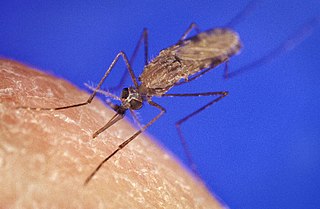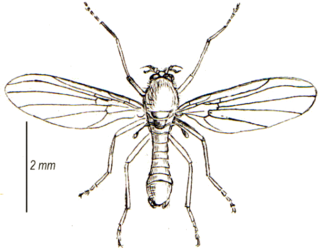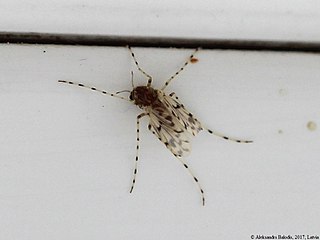Further reading
- Saether, O. A. 1975. Nearctic and Palaearctic Heterotrissocladius (Diptera, Chironomidae). Fisheries Research Board of Canada. Bulletin – no.193.
| Heterotrissocladius | |
|---|---|
| Scientific classification | |
| Kingdom: | |
| Phylum: | |
| Class: | |
| Order: | |
| Suborder: | |
| Infraorder: | |
| Superfamily: | |
| Family: | |
| Subfamily: | |
| Genus: | Heterotrissocladius Spärck, 1923 |
Heterotrissocladius is a genus of European non-biting midges in the subfamily Orthocladiinae of the bloodworm family (Chironomidae).

The Culicomorpha are an infraorder of Nematocera, including mosquitoes, black flies, and several extant and extinct families of insects. They originated 176 million years ago, in the Triassic period. There are phylogenetic patterns that are used to interpret bionomic features such as differences in the nature of blood-feeding by adult females, daytime or nighttime feeding by adult females, and occurrence of immature stages in aquatic habitats.

A midge is any small fly, including species in several families of non-mosquito Nematoceran Diptera. Midges are found on practically every land area outside permanently arid deserts and the frigid zones. Some midges, such as many Phlebotominae and Simuliidae, are vectors of various diseases. Many others play useful roles as prey for insectivores, such as various frogs and swallows. Others are important as detritivores, and form part of various nutrient cycles. The habits of midges vary greatly from species to species, though within any particular family, midges commonly have similar ecological roles.

The Chironomidae comprise a family of nematoceran flies with a global distribution. They are closely related to the Ceratopogonidae, Simuliidae, and Thaumaleidae. Many species superficially resemble mosquitoes, but they lack the wing scales and elongated mouthparts of the Culicidae.

Thaumaleidae, the solitary midges or trickle midges, are a group of nematoceran flies related to the Ceratopogonidae, Chironomidae, and the Simuliidae. They are small, stocky, yellow to brown flies (3–4 mm). Very few species are known for this family. Larvae are found in films on rocks and the nonfeeding adults are usually found on foliage along the same streams in which the larvae are found. A few solitary midges are found in the Southern Hemisphere, but Thaumaleidae are generally an Holarctic family.

Chaoboridae, commonly known as phantom midges or glassworms, is a family of fairly common midges with a cosmopolitan distribution. They are closely related to the Corethrellidae and Chironomidae; the adults are differentiated through peculiarities in wing venation.

The Chironomoidea are a superfamily within the order Diptera, suborder Nematocera, infraorder Culicomorpha. This superfamily contains the families Chironomidae, Ceratopogonidae, Simuliidae, and Thaumaleidae.

Nepenthesinfauna are the organisms that inhabit the pitchers of Nepenthes plants. These include fly and midge larvae, spiders, mites, ants, and even a species of crab, Geosesarma malayanum. The most common and conspicuous predators found in pitchers are mosquito larvae, which consume large numbers of other larvae during their development. Many of these animals are so specialised that they cannot survive anywhere else, and are referred to as nepenthebionts.

Ernst Josef Fittkau was a German entomologist and herpetologist.
Antillocladius is a genus of midges belonging to the family Chironomidae, subfamily Orthocladiinae. The name Antillocladius means orthoclad that occurs in the Antilles, where it was primarily recorded.

Orthocladiinae is a subfamily of midges in the non-biting midge family (Chironomidae). For lack of a better common name, they are simply referred to as orthoclads.

The genus Axarus is widely distributed with records from the Holarctic, the Neotropics and Australasia . There are currently 5 described nearctic species . Erected as a subgenus (Anceus) of Xenochironomus , Axarus was subsequently renamed and elevated to generic status . The Connecticut River in the eastern United States harbors locally dense populations of two Axarus species, both currently undescribed. These populations are interesting in that they are restricted to specific larval habitat and thus there is genetic structure between populations in the river . The Connecticut River species are also notable in that they have extremely well developed polytene chromosomes and also maintain a high degree of inversion polymorphism .

Kealia Pond National Wildlife Refuge is a coastal salt marsh along the south-central coast of Maui, Hawaiʻi. The refuge is located between the towns of Kihei and Maalaea, on both sides of North Kihei Road, Route 31. The wetland is also a 691-acre (2.80 km2) bird sanctuary, home to 30 species of waterfowl, shorebirds, and migratory ducks, including the ʻaukuʻu and the endangered āeʻo and ʻalae keʻokeʻo. Kealia Pond was selected as a wildlife refuge in 1953, protecting an initial 300 acres (1.2 km2) of land. The refuge joined the National Wildlife Refuge System in 1992.
Gymnometriocnemus is a genus of non-biting midges in the subfamily Orthocladiinae of the bloodworm family (Chironomidae). The genus is divided into two subgenera, Raphidocladius Sæther 1983 and Gymnometriocnemus Goetghebuer, 1932. Males of the former subgenus are characterized by possessing an extremely long virga with needle-like sclerotization, species of the later characterized by a short virga and a weakly developed crista dorsalis in the adult male hypopygium.

Chironomus is a genus of nonbiting midges in the subfamily Chironominae of the bloodworm family, Chironomidae, containing several cryptic species that can only be distinguished by experts based on the characteristics of their giant chromosomes.

Chironominae is a subfamily of midges in the non-biting midge family (Chironomidae).

Polypedilum is a genus of non-biting midges in the subfamily Chironominae of the bloodworm family Chironomidae. This is probably the most species-rich of all chironomid genera. Larvae of Polypedilum may also be among the most abundant invertebrates in eutrophic ponds, reaching densities of up to 1200 larvae per square meter.
Buchonomyia is the only extant genus of the subfamily Buchonomyiinae of the non-biting midge family Chironomidae. There are three known extant species and one fossil species in the genus: Members of the genus are parasitic of psychomyiid caddisflies.

Tanypodinae is a subfamily of midges in the non-biting midge family (Chironomidae). The larvae are generally carnivorous and their mouthparts are adapted for predation on small invertebrates although 1st and 2nd instar larvae also feed on algae.

Diamesinae is a subfamily of midges in the non-biting midge family (Chironomidae).

Ole Anton Sæther was a Norwegian entomologist.